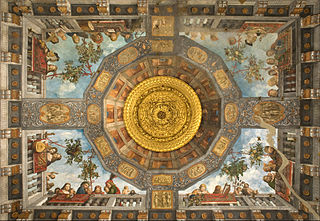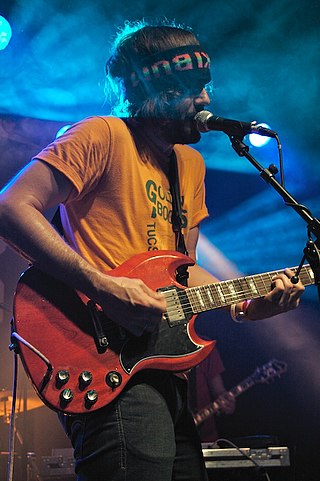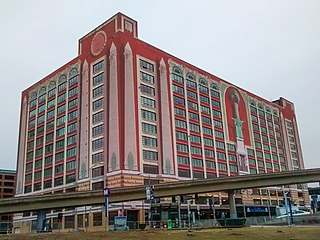
Victoria University is a federated university, which forms part of the wider University of Toronto. Affiliated with the United Church of Canada, the university was founded in 1836 as a college in the Wesleyan Methodist tradition.

Cobourg is a town in the Canadian province of Ontario, located in Southern Ontario 95 km (59 mi) east of Toronto and 62 km (39 mi) east of Oshawa. It is the largest town in and seat of Northumberland County. Its nearest neighbour is Port Hope, 7 km (4 mi) to the west. It is located along Highway 401 and the former Highway 2. To the south, Cobourg borders Lake Ontario. To the north, east and west, it is surrounded by Hamilton Township.

Trompe-l'œil is an artistic term for the highly realistic optical illusion of three-dimensional space and objects on a two-dimensional surface. Trompe l'œil, which is most often associated with painting, tricks the viewer into perceiving painted objects or spaces as real. Forced perspective is a related illusion in architecture.

Northumberland County is an upper-tier municipality situated on the north shore of Lake Ontario, east of Toronto in Central Ontario. The Northumberland County headquarters are located in Cobourg.

Chinatown is a neighbourhood in Vancouver, British Columbia, and is Canada's largest Chinatown. Centred around Pender Street, it is surrounded by Gastown to the north, the Downtown financial and central business districts to the west, the Georgia Viaduct and the False Creek inlet to the south, the Downtown Eastside and the remnant of old Japantown to the northeast, and the residential neighbourhood of Strathcona to the southeast.

Massey Hall is a performing arts theatre in Toronto, Ontario, Canada. Opened in 1894, it is known for its outstanding acoustics and was the long-time hall of the Toronto Symphony Orchestra. An intimate theatre, it was originally designed to seat 3,500 patrons, but after extensive renovations in the 1940s, it now seats up to 2,765. It has an extensive history of concerts by artists of many musical genres which continues today.
Richard John Haas is an American muralist who is best known for architectural murals and his use of the trompe-l'œil style. Haas has a 1959 B.S. from the University of Wisconsin–Milwaukee and a 1964 M.F.A. from the University of Minnesota.

Convocation Hall is a domed rotunda on the grounds of the University of Toronto in Toronto, Ontario, Canada. Designed by Darling and Pearson and completed in 1907, its radially planned interior has been compared to the grand amphitheatre of the Sorbonne and the Sheldonian Theatre at Oxford, although no specific precedent is truly known. While the building's namesake purpose is to host the annual convocation ceremonies, it also serves as the venue for academic and social functions that involve large audiences throughout the year.

The Capitol is an historic theatre on Swanston Street in the central business district (CBD) of Melbourne, Victoria, Australia. Opened in 1924 as part of the Capitol House building, the art deco theatre was designed by American husband and wife architects Walter Burley and Marion Mahony Griffin, and is the oldest of Melbourne's large picture palaces. It is famous for its extravagant decor and abstract motifs, including an intricate geometric ceiling containing thousands of coloured lamps, designed to evoke the walls of a crystalline cave.

Malajube is a Canadian francophone indie rock band formed in Montreal, Quebec.

The J. C. Penney Co. Warehouse Building, formerly also known as Edison Brothers Warehouse Building, and now Edison Condominiums, is a historic warehouse building in downtown St. Louis, Missouri. The building now serves as a condo-hotel.

The Wood County Courthouse and Jail, located in Bowling Green, Ohio, United States, is Wood County's third courthouse. It was built after citizens decided to move the county seat from Perrysburg to Bowling Green. Ground was broken on November 28, 1893, and the cornerstone was laid on July 4, 1894. The architectural firm of Yost & Packard of Columbus designed the courthouse and construction was overseen by T.B. Townsend of Youngstown. The winning tender for the project was $153,803 and the final construction costs totaled $255,746.

John Pugh is an American artist known for creating large trompe-l'œil wall murals giving the illusion of a three-dimensional scene behind the wall. Pugh has been creating his murals since the late 1970s. He attended California State University Chico, receiving his BA in 1983 and the Distinguished Alumni Award in 2003. He has received over 250 public and private commissions in the United States, Canada, Mexico, Barbados, Japan, Taiwan, and New Zealand. He currently lives and works in Truckee, California. His particular style of trompe-l'œil painting has been called "Narrative Illusionism."

Ocean Island Inn is a historic building in Victoria, British Columbia, Canada; it is Vancouver Island's largest backpackers' inn.

The Unitarian Church is a historic American church on Exeter Road in Hampton Falls, New Hampshire. Built in 1838, it is a rare example of an in antes Greek Revival temple front in the state, and is distinguished by the presence of Victorian trompe-l'œil panels and ribbing on its interior walls. The church was listed on the National Register of Historic Places in 1984. It is presently used for services in the summertime.

Calgary City Hall, is the seat of government for Calgary City Council, located in the city's downtown core of Calgary, Alberta, Canada. The historic building completed in 1911 serves as the offices for Calgary City Council, consisting of the office of the Mayor, fourteen Councillors and municipal Clerk. Calgary City Hall originally housed the municipal council and portions of administration from its completion in 1911 until the construction of the Calgary Municipal Building adjacent to Old City Hall in 1985, which currently houses the offices of 2,000 civic administrators.
Juanqinzhai, or the "Studio of Exhaustion From Diligent Service", is a hall in the Palace of Tranquil Longevity built by the aging Qianlong Emperor as part of his retirement suite. After announcing his desire to retire from the throne, the emperor began building a retirement suite, the Palace of Tranquil Longevity, in the northeast corner of the Forbidden City. This complex, also called the Qianlong Garden, was built with the highest quality and designed with the most exceptional Chinese techniques. Juanqinzhai was an imperial lodge in the north end of the garden, and contains rare examples of murals painted on silk and bamboo craftsmanship.

















